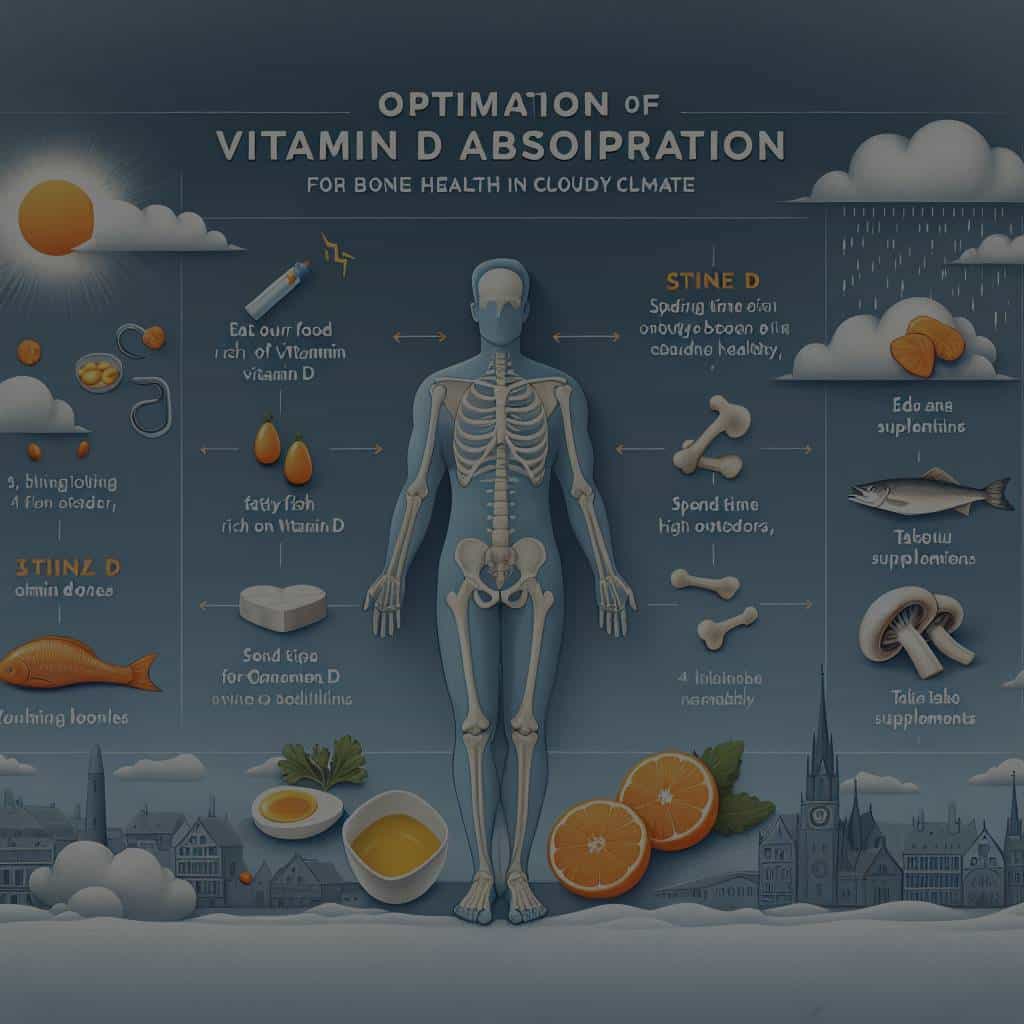How to Optimize Vitamin D Absorption for Bone Health in Cloudy Climates?

When it comes to maintaining your overall health, vitamins are crucial. One such essential vitamin is vitamin D, often referred to as the "sunshine vitamin." This is because our bodies naturally produce it when exposed to sunlight, specifically the ultraviolet B (UVB) rays. However, for those living in cloudy, sun-deprived climates, achieving optimal vitamin D levels can be a challenge. The question then arises: How can you optimize vitamin D absorption for bone health in such climates? This article explores this issue, shedding light on the importance of vitamin D, the risks associated with deficiency and ways to improve vitamin D status in the body.
The Importance of Vitamin D for Health and Skin
The significance of vitamin D in the human body extends beyond simply aiding in calcium absorption and promoting bone health. Recent studies have elucidated the vitamin’s role in multiple bodily functions.
Topic to read : What Is the Role of Occupational Therapy in Managing Post-Stroke Rehabilitation?
Vitamin D is a fat-soluble vitamin that our skin synthesizes when exposed to sun, more specifically UVB radiation. When UVB rays strike the surface of our skin, our bodies convert a cholesterol derivative into a form of vitamin D known as D3, or cholecalciferol. This vitamin D3 is then transported to the liver and kidneys to be transformed into its active form, which is used by the body.
This vitamin is instrumental in maintaining bone health by aiding in the absorption of calcium and phosphorus, two minerals essential for bone formation. Without sufficient vitamin D, bones can become thin, brittle, or misshapen.
Also to read : How Does the Use of Blue Light Filtering Glasses Impact Sleep Quality in Adolescents?
Moreover, a growing body of scholarly research suggests that vitamin D plays a vital role in immune system regulation, reducing the risk of developing autoimmune diseases, and could even have cancer-preventing qualities.
Understanding Vitamin D Deficiency
Deficiency in vitamin D is not an uncommon phenomenon, especially among those living in areas with less sun exposure. A lack of this vitamin can lead to a host of health problems.
Vitamin D deficiency is often subtle and many people may not realize that they are deficient. Symptoms can range from tiredness and general aches and pains, to severe bone or muscle pain and weakness that may make it difficult to climb stairs or get up from the floor or a low chair.
Prolonged deficiency can lead to complications such as osteomalacia, or softening of the bones, in adults and rickets in children. Moreover, emerging research indicates that inadequate levels of vitamin D may be associated with an increased risk of certain types of cancers, autoimmune diseases, hypertension, and certain infectious diseases.
Strategies to Optimize Vitamin D Absorption
Despite living in sun-deprived, cloudy climates, it is possible to maintain optimal vitamin D levels. Here are some strategies to enhance vitamin D absorption in the body.
Dietary Sources
People living in cloudy climates can rely on dietary sources of vitamin D. Foods that are naturally rich in this vitamin include fatty fish like salmon, mackerel, and sardines, fish liver oils, and egg yolks. Several kinds of mushrooms, like maitake and chanterelles, when exposed to UV light, also contain significant levels of vitamin D.
Moreover, many foods are fortified with vitamin D, such as milk, orange juice, and breakfast cereals. Including these foods in your daily diet can help increase your vitamin D intake.
Vitamin D Supplements
Another way to ensure you’re getting enough vitamin D is to take dietary supplements. Supplements can help you reach the necessary intake especially during the winter months when sun exposure is minimal. It’s important to note that while supplements can help, they should not replace a balanced diet. Always consult a healthcare provider before starting any supplement regimen.
Maximizing Sun Exposure
Even in cloudy climates, the sun’s UVB rays can penetrate through the atmosphere. When the sun is out, try to expose your skin for about 15 minutes each day. Mid-day is the best time, as this is when UVB rays are the most intense. Remember to apply sunscreen after this time to reduce the risk of skin cancer.
The Relationship between Vitamin D and Skin Cancer Risk
While it’s important to get enough sun exposure for vitamin D synthesis, there is a fine line between beneficial and harmful sun exposure. Excessive sun exposure, especially sunburn, can increase your risk of skin cancer.
Vitamin D and its metabolites help to protect the skin from the damaging effects of the sun, thus playing a protective role against skin cancer. However, it’s important to balance the need for sun exposure to produce vitamin D with the need to limit it to reduce skin cancer risk.
The American Academy of Dermatology recommends against obtaining vitamin D from unprotected exposure to sunlight or indoor tanning devices, due to the increased risk of skin cancer. Instead, they recommend achieving adequate vitamin D levels through a healthy diet that includes vitamin D-fortified foods and beverages, and vitamin D dietary supplements.
Remember, your health is a multifaceted entity. While the focus of this article is on optimizing vitamin D absorption, it’s equally important to maintain a balanced diet, regular physical activity, and to consult your healthcare provider for regular check-ups, particularly if you are at risk for vitamin D deficiency.
The Role of Skin Pigmentation and Latitude on Vitamin D Levels
Another important factor that influences vitamin D status is the level of a person’s skin pigmentation. Melanin, the pigment that determines skin, hair, and eye color, absorbs UVB radiation and reduces the skin’s ability to produce vitamin D3. Higher levels of melanin in the skin, or darker skin, can reduce the skin’s ability to produce vitamin D3 by up to 99%.
Furthermore, the latitude and altitude of the place where you live can significantly influence your ability to produce vitamin D from sun exposure. This is because the angle at which the sun’s rays hit the Earth changes with latitude and altitude. The further from the equator, the less UVB radiation reaches the Earth’s surface, especially during the winter months.
This means that people living at higher latitudes or altitudes, where the sun’s rays are less direct, have more difficulty producing sufficient vitamin D. This challenge is even greater during the winter months when daylight hours are shorter. Therefore, residents of such areas should pay particular attention to their vitamin D intake and may need to consider vitamin supplementation.
The Role of Vitamin Supplementation and Monitoring Serum Levels
Given the numerous obstacles to obtaining adequate vitamin D from sun exposure, vitamin D supplementation becomes an essential tool in preventing vitamin deficiency. Studies cited by Google Scholar and Pubmed show that vitamin supplementation can effectively increase vitamin D serum levels, especially in those residing in high latitude locations with less UVB light availability.
However, it’s worth noting that not all supplements are created equally. The two main forms of vitamin D supplements are D2 (ergocalciferol) and D3 (cholecalciferol). According to several studies, vitamin D3 is more effective than vitamin D2 at raising and maintaining adequate serum levels of vitamin D.
Healthcare providers can monitor your vitamin D status through a simple blood test to measure serum levels of 25(OH)D, the main form of vitamin D in the blood. The United States National Institutes of Health recommends that adults aim for a serum level of 20 nanograms/milliliter to 50 ng/mL.
In Conclusion: Optimizing Vitamin D for Bone Health in Cloudy Climates
In conclusion, achieving optimal vitamin D levels for bone health in cloudy climates may require a multifaceted approach. This can include maximizing safe sun exposure, increasing dietary vitamin intake, and considering the use of vitamin D supplements.
Skin pigmentation and geographical location factor greatly into an individual’s vitamin D production capacity. Therefore, individuals with darker skin living in high latitude or altitude locations may need to pay particular attention to their vitamin D status.
Remember, maintaining adequate vitamin D levels is essential not only for bone health but also for a wide array of bodily functions, including immune system regulation. Regular monitoring of serum levels and consultation with a healthcare provider can ensure you achieve and maintain optimal vitamin D status. Despite the challenges posed by cloudy climates, with the right strategies, healthy vitamin D levels are an achievable goal.
